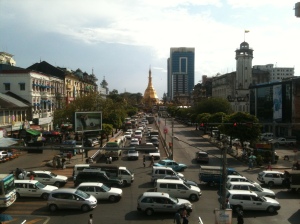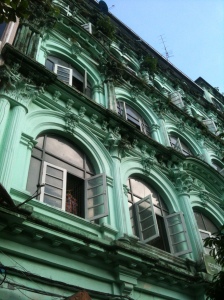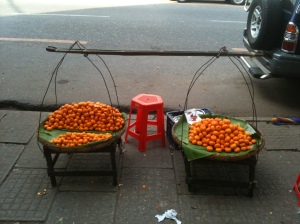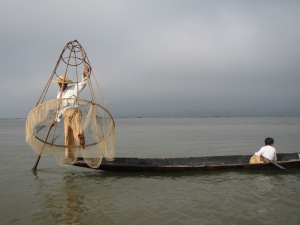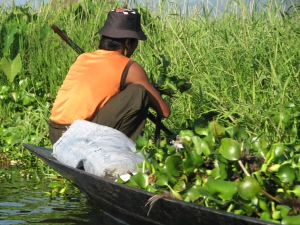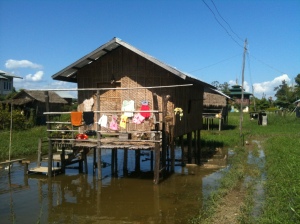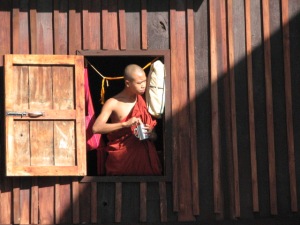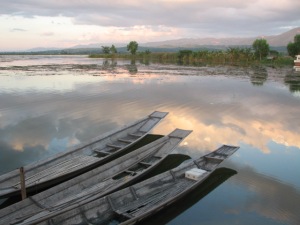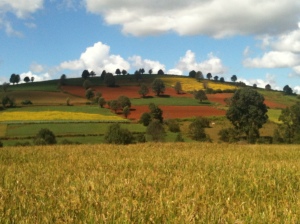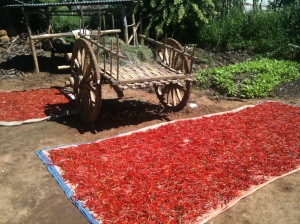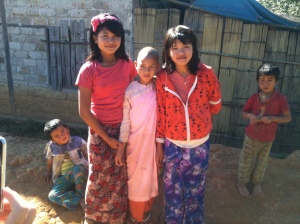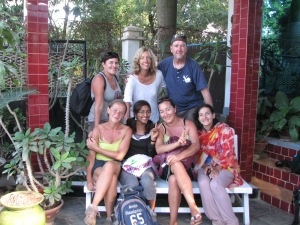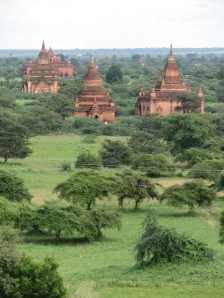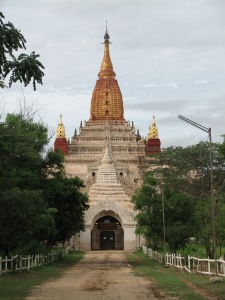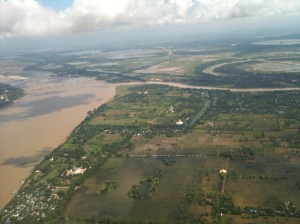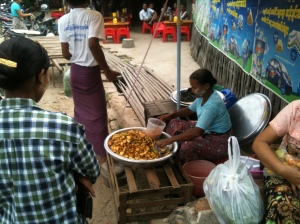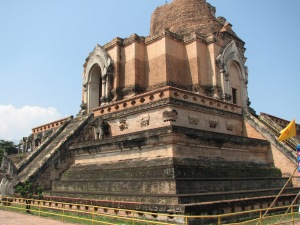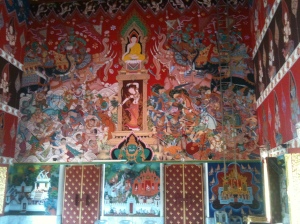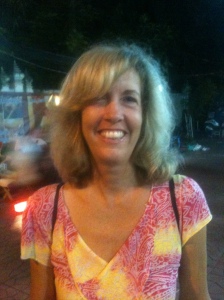Should’ve learned by now not to judge an Asian town at night time. In the morning, those barren gritty streets and connecting alleys were buzzing in all directions. It was hot, bright and sunny. The elevated sidewalks were lined with the usual interesting hoards of food stalls, sewing machines, betelnut stands, and in our particular neighborhood, used books. Shrines and shrouds encircled the bases of wide banyan trees. Lots of walkers loitered or strolled along wide streets, filled with empty trishaws, crowded buses and white Toyotas, which began pouring into Yangon 2 years ago at a clip of 10,000 per month -rush hour traffic having turned abysmal as a result. Noticeably missing from the streets were motorbikes, ironically, since they greatly help aleve traffic congestion. The story goes that years ago, one sideswiped the car of a military general, who then banned them from the entire city.
Our main goal for the day was to obtain overnight ferry tickets to the southwest coast, but first we needed to eat. We ventured into a neighborhood just west of central Yangon, that -judging from the people and restaurants- could have been somewhere in India. Tarp-covered sidewalk stalls selling used jewelry, trinkets, magazines, cricket snacks, cigarettes, fruit, underwear, small Buddhas, skewers, water, books, watches, and t-shirts of Aung San Suu Kyi were everywhere, competing for attention with the brick and mortar shops just across the narrow, cracked sidewalk. Mosques and temples rose above the fray, alongside weathered, 3-story stucco buildings. The Biryani and lassi joint we found was as packed, interesting and delicious as our guide book described. This was a good beginning.
Finding the jetty, and the ticket office for the overnight ferry however, was a different matter. Maybe our taxi driver was new to Yangon, because I had to direct him where to go. Behind a long sea wall, a whole new world opened up. A man walking past our lost driver offered to help, and lead us on a long, convoluted search for the packed ticket office, which in turn lead to a similar search for the ferry. Finally we found it, parked on the outside of another ferry, which was being loaded up with cargo, and this was an amazing scene to watch. A hundred tired, sweaty, men, carried huge white sacks on their backs, onto this front ferry, unloaded as ordered, and then slouched back to the truck for more. We had to dodge and weave through this human ant nest to board “our” ferry, which was not at all what we expected for a 22-hour long excursion. No seats. No beds. We were offered a small square of dirty floor in a corner of the second level, crowded with boxes stacked to the ceiling. Despite what we were told, I still doubt that this was the correct ferry that our guide book referenced -it didn’t seem like a passenger ferry whatsoever, and yet was not cheap. We declined the offer -but only after much consideration. Maybe we’d have taken the plunge if we hadn’t just come off a difficult 16-hour train ride, which seemed now like a luxurious arrangement when compared to this.
We headed back to the Indian neighborhood, to a western cafe we’d seen called the Boon Bar. Next door, in an indoor mall, was a travel agent who both cleared and muddied our prospects for leaving Yangon. There was also a medical clinic, which Jennifer took advantage of to address a lost appetite and stomach pain she’d been having for days, and weight loss. She felt that the young woman Dr there gave her excellent care and advice (avoid spicy -not easily done here), and a prescription for a stomach infection. On the walk home we checked out several hotels, hoping to find one cheaper than ours. But this search instead made us feel thankful for what we had. Some of those other places were interesting, but quite creepy –and more expensive than ours. We hadn’t expected to stay in Yangon that night, and so hadn’t booked our room -leaving our day packs at the front desk. We returned to our hotel after dark, desperately hoping they’d still have a room available, which they did -along with a smile.
We were still hoping to get away to remote southern or coastal destinations in the days ahead, while we explored Yangon and monitored Jennifer’s health. The Circle Train takes 3 hours and passes around the outskirts. I liked it more than Jennifer -who became disheartened by the sights of poor communities that we passed early on. She got off the train after one hour, but I stayed on board for the whole experience. I mostly stood at -and leaned out of- the open doors in back, but also sat with a friendly monk for a while. The northern region was open and beautiful, and green with rows of vegetables. I didn’t realize they were floating crops until I saw the heads of women harvesters alongside them, in water up to their chins.
Jennifer’s loss of appetite was becoming an issue, and we needed a western dinner. We walked many blocks to a particular Italian restaurant, but which was now out of business. In desperation, we broke down and decided to eat in a western tourist hotel nearby -something we’d avoided doing because of the mutual arrangement these places have with the corrupt Myanmar government. The dining room was barren and boring, the staff barely spoke English, the food was expensive, and not very good, and as we walked out, I had a sinking feeling that for the second time in my life, I had food poisoning -soon validated. The irony of getting poisoned at this westernized tourist restaurant after all the places we’d been eating did not escape me! It was a long night, and long day that followed, which I spent in our room. Jennifer took care of me lovingly, as best she could.
As I slept all the next day, she headed off to run some tasks. She didn’t return until it was dark and late, and then she didn’t look well at all. She recounted her day, and told me about sitting in a restaurant and becoming overwhelmed with weakness, nearly collapsing. Fortunately she was near that medical clinic, and was able to drag herself back to that same doctor, who put her on 2 hours of IV and recommended that she be hospitalized. Our conditions traded places then, as I recovered and Jennifer then stayed put in our room (though I lost my appetite for the next week). She looked absolutely terrible, and had lost far too much weight, yet I could not convince her to go to the hospital. This became a strongly felt area of contention between us, which didn’t help matters. What she did agree to do was let go of her strident diet, and to start eating anything and everything that she could. I went out and scoured the shops for Ensure, breakfast bars, oatmeal, crackers, milk, and other things that she hadn’t had for years. And I found a book or 2 to help her pass the time. It was a bit scary there for a spell. She simply could not will herself to eat, yet needed to. It took a few days for her to even start to feel better. One word: Ensure.
By now, there weren’t many days left before our visa expired, and we began to accept -and embrace- the thought of staying put in Yangon.
-matt

